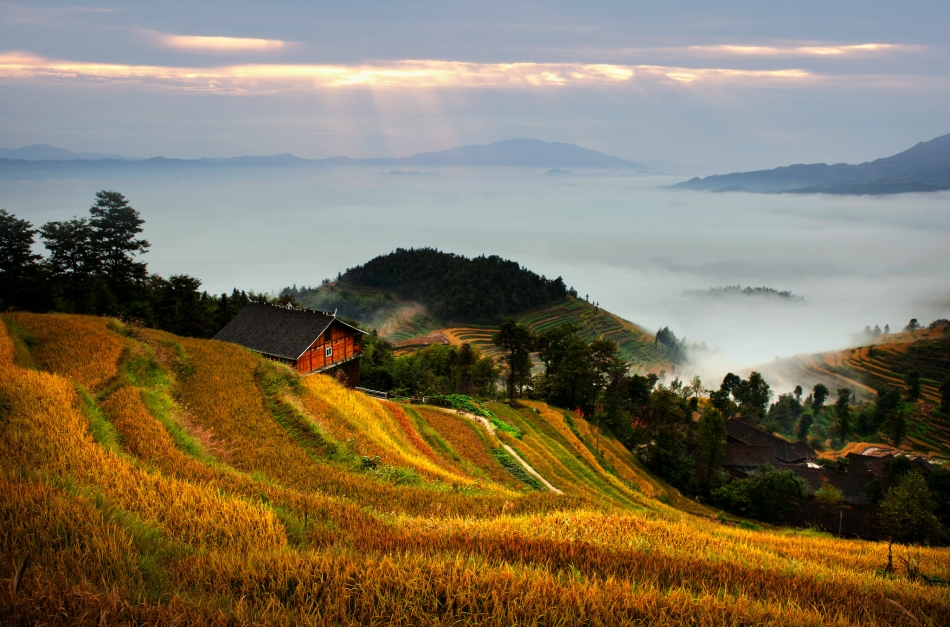Nature, farming, and tourism intersect.

At first, it felt reminiscent of entering a Bob Dylan song—maybe one of his famed Latino ballads. Amid dusty paths, shared exclusively with cowboys on horseback, our journey began. We traversed weathered bridges adorned with rust and enormous spider webs. In the middle of the road, a caracara falcon feasted on a motionless iguana. Yet, as we moved away from ranching grounds, a pineapple desert unfurled before us. The approaching night swallowed us in darkness as the trail ascended into hills cloaked in jungle. Finally, we reached a gate distinguished by an unusual metal sculpture. Jovino, our driver, shrugged and remarked, “This must be it.”
We were now in Costa Rica, far from the typical tourist attractions, in an area known as Biolley, close to the Panamanian border.
During a prolonged and winding drive, the headlights revealed a series of unexpected sights: a multitude of frogs hopping across the road, an owl elegantly gliding through clouds tangled in a bamboo forest, cascading waterfalls, and more of the strange sculptures. This, I realized, was not Dylan; it was Dalí.
Costa Rica flaunts a thriving tourism sector, drawing in a substantial number of visitors—approximately 3 million annually before the pandemic—by championing environmental values. The country safeguards extensive stretches of protected land and adheres to progressive attitudes toward wildlife. Here, one won’t encounter monkeys restrained by chains or macaws confined to cages masquerading as “rescued” birds. The prominent national parks deliver on their promises, exhibiting remarkable fauna and awe-inspiring landscapes. Moreover, this small, demilitarized Central American nation offers free healthcare, dependable law enforcement, and high literacy rates.
But is everything perfect? Not entirely. Beyond the main parks, there exists another facet of Costa Rica—a realm where intensive industrial farming of bananas, sugar cane, palm oil, pineapples, and coffee serves as the primary income source for many. Within these areas, communities striving to protect their natural environment from the chemical-intensive methods of monoculture face hurdles in gaining attention. Exploring these initiatives and connecting with individuals involved can be advantageous for both the environment and your expedition.
Witnessing massive-scale tropical fruit cultivation is far from picturesque. Once the heavily sprayed fields deplete, they undergo herbicide treatment, plowing, and the introduction of synthetic fertilizers and cloned plants. Unfortunately, this business model pervades in farming practices globally, including in countries like Britain. However, while we may have grown accustomed to our depleted countryside and even developed an affection for it, in a region blessed with extraordinary biodiversity, it can be a jolting experience. After all, this small country, which is half the size of Iceland, is home to approximately 5% of all known species on Earth. Many visitors come specifically to witness the remarkable wildlife rarities, such as the resplendent quetzal or the harpy eagle.
As Jovino and I approach the end of the lengthy trail, lights illuminate the hillside above us. Utilizing our phones as makeshift torches, we navigate through bushes until we reach a terrace adorned with a delightful coffee shop. Behind the counter, brimming with cakes and coffee packets, stands a roasting oven. Upon closer inspection, I notice tea crafted from coffee flowers. Finally, I have the pleasure of meeting the couple at the core of this enchanting jungle realm: Gonzalo and Fanny Hernández.
“It’s a bit late for coffee,” remarks Fanny, “but you should try some coffee blossom tea.” I oblige, and to my delight, it turns out to be exquisitely delicious, with a delicate flavor.
Gonzalo arranges the chairs, and we quickly engage in a spirited discussion on his favorite subject: coffee. “The majority of coffee cultivated worldwide comes from a single variety of a single species,” he explains. “And just like any monoculture, it is susceptible to vulnerabilities. A single pest can devastate an entire crop practically overnight. With the advent of climate change, this danger only intensifies. Monocultures must adapt and embrace biodiversity. That’s the very notion I aim to demonstrate here.”
Having previously worked in the coffee industry, Gonzalo made the decision to purchase land and establish Coffea Diversa—a botanical collection comprising over 600 coffee tree varieties sourced from various corners of the globe. “We don’t eradicate the jungle and indiscriminately spray everything,” he emphasizes. “Instead, we collaborate with the forest. Tomorrow, I will show you firsthand.”
Toucans gracefully glide above me, while hummingbirds dart by with a magical whir, resembling miniature trimmers.
To my surprise, I find that my bed is nestled within one of the peculiar metal sculptures. It is one of the most unconventional hotels imaginable, yet unexpectedly comfortable. As dawn breaks, I awaken to a breathtaking vista of the jungle and agroforestry. Toucans gracefully swoop overhead, while the hills echo with the melodious liquid songs of oropendolas, resembling large crow-like birds. Hummingbirds whiz past my ears, akin to magical miniature strimming machines.
Gonzalo awaits my presence. “The toucans feast on the coffee berries. Most coffee farmers despise them, but we welcome their presence,” he explains. He leads me to a row of coffee bushes heavily laden with vibrant red berries and points beneath them. “You see? We collect these.”
Gonzalo clarifies that the toucans carefully select the finest coffee berries to consume, subsequently excreting the beans. He and his team collect these droppings. Curious, I inquire if he intends to emulate the Southeast Asian coffee producers who confine civet cats to force-feed them coffee berries, resulting in the famed and valuable kopi luwak. He recoils in disgust. “Never. Furthermore, treating wild creatures in such a manner is strictly prohibited in Costa Rica.”
On this remarkable farm, Gonzalo demonstrates the harmonious coexistence of tourism, agriculture, and diverse nature. I spend the entire morning observing the toucans, as they diligently focus on the wild fruits of the guarumo trees. Gonzalo allows these trees to thrive among the coffee plants, with the toucans inspecting the branches, tilting their heads with measured precision before delicately selecting their pickings with their formidable beaks. Such a level of harvesting accuracy is beyond human capabilities. The following day, I embark on a hike to explore the area’s enchanting waterfalls with José from Asomobi, a cooperative society that supports local farmers in developing projects related to tourism, organic practices, and agroforestry.
Several days later and a few miles to the north, I stumble upon a different style of coffee farming. San Jerónimo, a rugged and untamed jungle region, remained uninhabited until enterprising settlers arrived from Panama in the aftermath of the Second World War. They painstakingly cleared the land and planted Coffea arabica trees, eking out a modest existence, but never amassing great wealth. To this day, their coffee berries are sold at meager prices.
I have the pleasure of meeting Ken Gallatin, who initially arrived in this area as a Peace Corps volunteer during the 1980s and decided to make it his permanent home. “When I first arrived, there were no cars here,” he recounts. “Only horses and mules.” Even now, the influence of the outside world is faint


